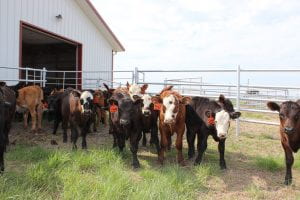by Gregg Hanzlicek, DVM, Veterinary Diagnostic Lab
Vaccines are an essential tool to help optimize cattle health. Sometimes it appears that a particular vaccine or vaccine program has failed to protect individuals and prevent herd disease outbreaks. Are there practices that can negatively impact vaccine effectiveness?
There are five broad areas that can negatively affect vaccine effectiveness: 1) Vaccine timing, 2) Vaccine administration, 3) Vaccine handling, 4) Vaccine selection, 5) Biological reality.
Vaccine administration timing
At birth, calves possess all the essential components of an immune system. But many of those components are not functional or are not effective until several weeks of age. Additionally, beginning about nine days prior to birth and extending ten or more days after birth, calves are exposed to high levels of natural hormones. These hormones are produced primarily by the calf to initiate parturition and without their presence, birth would not occur. Unfortunately, these hormones are highly immunosuppressive. Therefore, calves vaccinated in the first few weeks of life may not be able to mount an effective immune response for two reasons. 1) Their immune system is not completely functional, and 2) the functioning portion of the immune system may be suppressed because of calving-hormone exposure. Delaying vaccinations until calves are several weeks of age is a good way to allow the immune system some time to mature and allow time for the immunosuppressive hormones to decrease, both which may help assure that calves can respond appropriately.
Another obstacle to effectively immunizing young calves is the presence of maternal antibodies. Calves are born devoid of any circulating antibodies. To assure optimal young calf health they must consume and absorb colostrum antibodies within a few hours of birth. As important as these antibodies are, their presence may interfere with the ability of both modified live and killed vaccines to stimulate an effective immune response. The maternal antibodies have a limited lifespan and disappear naturally as the calf ages, with most of the antibodies gone by four to six months of age. When vaccinating young calves, the presence of maternal antibodies may reduce vaccine effectiveness; vaccinating at several weeks to months of age will lessen the negative effects of maternal antibody interference.
For vaccines to provide protection for any age of animal, the immune system must have sufficient time to respond to the vaccine and mount an immune response. The amount of time depends on the vaccine type and can range from a few days (intranasal vaccines) to several weeks (injectable vaccines). If the vaccines are given to animals already harboring the virus or bacteria or to animals that are exposed to disease shortly after vaccine administration, there won’t be sufficient time to mount a protective vaccine immune response. Of course it isn’t always possible, but designing a vaccination program with the timing of the anticipated disease exposure in mind can help assure animals have sufficient time to mount an immune response.
Vaccine booster timing is also very important when using most killed vaccines. Booster vaccine injections are necessary in animals that have not been previously vaccinated with that particular vaccine. The first killed vaccine injection will stimulate an immune response, but a rather weak response. When a second/booster injection is administered it stimulates a much greater immune response (called an amnestic response). If a booster is not given at all or the amount of time between the first and second vaccine injection is either too long or too short, the amnestic response may not occur. For most killed vaccines, the first time animals are administered the vaccine, two doses are required; following the labeled between-dose timing (weeks) is an extremely important component of the vaccine program.
Vaccine administration
How vaccines are administered can also influence vaccine effectiveness. One issue that can occur when trying to be efficient when vaccinating large groups of cattle is under-dosing. Regardless of if the labeled dose is 2cc or 5cc, the entire dose must be administered to each and every animal. When the entire dose is not injected (either intranasally or subcutaneously or intramuscularly), many times there is not enough vaccine in the animal to stimulate the animal’s immune system.
Administrating the vaccine in a way that is not included on the label can negatively affect response. For example, vaccines labeled for subcutaneous administration can end up as intramuscular injections. Vaccines are developed, designed, and evaluated according to one or more specific routes of administration. If injected through an unevaluated route, the vaccine will likely not perform as effectively as designed. Always read the vaccine directions for route of administration and choose the appropriate needle length given the size of the animal and route.